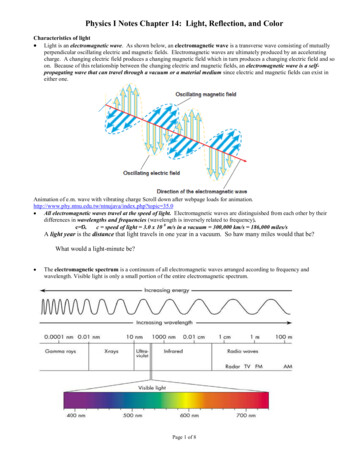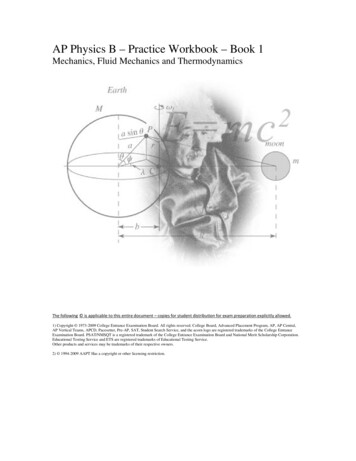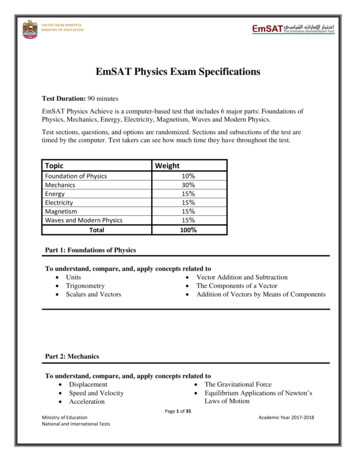
Transcription
Physics I Notes Chapter 14: Light, Reflection, and ColorCharacteristics of light Light is an electromagnetic wave. As shown below, an electromagnetic wave is a transverse wave consisting of mutuallyperpendicular oscillating electric and magnetic fields. Electromagnetic waves are ultimately produced by an acceleratingcharge. A changing electric field produces a changing magnetic field which in turn produces a changing electric field and soon. Because of this relationship between the changing electric and magnetic fields, an electromagnetic wave is a selfpropagating wave that can travel through a vacuum or a material medium since electric and magnetic fields can exist ineither one.Animation of e.m. wave with vibrating charge Scroll down after webpage loads for x.php?topic 35.0 All electromagnetic waves travel at the speed of light. Electromagnetic waves are distinguished from each other by theirdifferences in wavelengths and frequencies (wavelength is inversely related to frequency).c fλλc speed of light 3.0 x 10 8 m/s in a vacuum 300,000 km/s 186,000 miles/sA light year is the distance that light travels in one year in a vacuum. So haw many miles would that be?What would a light-minute be? The electromagnetic spectrum is a continuum of all electromagnetic waves arranged according to frequency andwavelength. Visible light is only a small portion of the entire electromagnetic spectrum.Page 1 of 8
Brightness or intensity of light decreases by the square of the distance from the source (inverse square law). .Question: How much would the brightness change if you were 3 times farther away from the source asyour classmate? Everything you see is light! You do not see people or objects - you only see the light they reflect!!Ray model of light Waves are often approximated as rays to predict the path with which they will travel. The ray model of light is based onthe assumption that light travels in a straight line in a vacuum or uniform medium. A ray is a straight line that represents thepath of a very narrow beam of light. Ray diagrams are drawings used to depict the path of light rays. Even though raydiagrams ignore the wave nature of light, they are useful in describing how light behaves at boundaries (reflection orrefraction) and often used to locate the image formed by a mirror or a lens.Behavior of light at a boundary Whenever light (or any wave) encounters a different medium one of three things can happen. The light can be absorbed bythe new medium and turned into internal energy and/or heat, the light can be transmitted through the new medium, or thelight can be reflected back into the original medium. In reality, what most often happens is a combination of the three fates.Good mirrors reflect about 90 percent of the incident light and absorb the rest. If the light is reflected the angle of thereflected ray will be equal to the angle of the incident ray. If the ray is transmitted into the new medium the ray may be bentor refracted. We will focus on reflection this chapter and on refraction next chapter.When Light encounters Matter The 3 possible “fates” to befall the energy of the light when it interacts with matter/substances:1. Reflected – Reflection of the light bounces the energy back into the same medium that it came from.2. Transmitted through – The light can travel through the new material while undergoing varying degrees ofinteraction with the substances’ molecules.3. Absorbed – The light energy can be completely absorbed into the molecules of the substance and turned into heat.We can categorize substances according to how light interacts with that substance’s molecules. Opaque objects absorb and/or reflect all light - light cannot get through. Transparent objects allows light to travel through in straight lines. Objects can be transparent to some colors orfrequencies of light and opaque to others. Regular standard glass is transparent to visible light, but is opaque to UV and IRlight. Translucent substances or objects scatter light in all directions as it passes through. Our atmosphere is translucent to visiblelight.Page 2 of 8
Reflection Reflection is the turning back of an electromagnetic wave at the surface of a substance. The Law of Reflection states thatthe angle of incidence angle of reflection. Typically the angles are measured with respect to the normal. The normal is aline drawn perpendicular to the surface at the point of VB/Harrison/Flash/Reflection/Reflection.html Reflection of rays off a surface will be regular or varied depending on the size of the irregularities of the surface relative tothe wavelength of the light incident on the surface. Specular (regular) reflection occurs when light is incident on a“smooth” surface and the rays are reflected parallel to each other. Diffuse reflection occurs when light is incident on a“rough” surface and the rays are reflected in many different directions.Mirrors In analyzing mirrors we will focus on the types of images they produce. Images are formed at the point where rays of lightactually intersect (real image) or from which they appear to intersect or come from (virtual image). Three characteristics are used in describing the image produced by a mirror –1. real or virtual,2. orientation (inverted or upright), and3. magnification (larger, smaller, or same size).Virtual images will be upright and real images will be inverted. Magnification is the ratio of the height of the image to the height of the object, which can also be calculated in terms of aratio of the distances. If the image is larger than the object, the magnification will be greater than one. If the image issmaller than the object, the magnification will be less than one. If the image is the same size as the object, the magnificationwill be one.M hid ihodoPage 3 of 8
Flat Mirrors A flat mirror will always produce an upright, virtual, unmagnified image, that is left-right reversed.the object to the mirror is equal to the distance of the image to the mirror.The distance ifpm.cfmSpherical Mirrors The type of image produced by a spherical mirror depends upon whether the mirror is concave (converging) or convex(diverging) and, for concave mirrors, whether the object is behind or in front of the focal point. The focal point is the pointat which rays parallel to the principal axis intersect (converge) after being reflected. The principal axis is a line drawnperpendicular (normal) to the surface of the mirror and passes through the focal point and center of curvature of the mirror.Focal length is the distance from the focal point to the mirror along the principal axis.The focal length is ½ the radius of curvature of the mirror.f IA/optics/rdcma.htmlImages produced by spherical mirrors To determine the type of image produced by a spherical mirror you can draw ray diagrams and/or use the mirror andmagnification equations. You will have to know how to do both. Four rules for finding images formed by spherical mirrors using ray diagrams. (Note – You only need to draw two raysto determine the point at which the image will form.)1. Incident rays parallel to the principal axis of a mirror are reflected through the focal point.2. Incident rays that pass through the focal point are reflected parallel to the principal axis.3. Incident rays that pass through the center of curvature are reflected back through the center of curvature.4. Incident rays drawn to the point of contact of the principle axis with the mirror will reflect at the same angle with whichthey hit (law of reflection).Page 4 of 8
Equations used for locating images and determining magnifications Mirror equationMagnification1 1 1 d o dif M hid ihodoSign conventions for mirrors do is (object is in front of mirror) di is if in front of mirror (real image) di is – if behind mirror (virtual image) r and f are for concave mirror r and f are – for convex mirror M is positive, upright M is negative, inverted In this course -Virtual images are always upright. Since the distance for a virtual image is negative, the magnificationwill be positive and the image is upright. Real images are always inverted. Since real images have a positivedistance, magnification will be negative and the image is inverted.Concave (converging) mirrors The type of image produced by a concave mirror depends upon the location of the object relative to the focal point andcenter of curvature. Real images are formed if the object is beyond the focal point.a. All incoming rays parallel to the axiswill reflect through the focal point.b. If the object is beyond the center ofcurvature, the image is inverted, real, andsmaller.c. If the object is at C, the image will bereal, inverted and the same size locatedalso at C.d. If the object is between the focal pointand center of curvature, the image isinverted, real, and larger.e. At the focal point no image is producedsince all rays would reflect parallel.f. If object is in front of focal point, theimage is upright, virtual, and /u13l3d.cfmPage 5 of 8
optics/rdcma.htmlExample 1:A concave spherical mirror has a focal length of 10.0 cm. Locate the image of a pencil that is placed upright 30.0 cm from themirror. Find the magnification of the image. Draw a ray diagram to confirm your answer.Object placed at:do Cdo Cf do Cdo fdo fImage distancedi No image-real or virtualrealrealrealNo imagevirtualupright orinvertedinvertedinvertedinvertedNo imageuprightlarger or smallersmallersame sizelargerNo imagelargerConvex (diverging mirror) mirrors Convex mirrors always produce images that are virtual, upright and smaller. Since the mirror is convex the center ofcurvature is behind the mirror and so is the focal point. Both values are negative when used in the mirror equation.Page 6 of 8
Parabolic mirrors Spherical aberration is the inability of a spherical mirror to focus all parallel rays to a single point. Parabolic mirrorseliminate spherical aberration by making all parallel rays pass through focal point. Parabolic mirrors are used in a variety ofcommon devices such as reflecting telescopes and flashlights because of their ability to focus the light more effectively thana spherical mirror.Color The color of an object depends on:1. which wavelengths of light shine on an object,2. which wavelengths are absorbed,3. and which are reflected. If all wavelengths of incoming light are completelyreflected by an object, that object appears the samecolor as the light illuminating it. An object of aparticular color absorbs light of all colors except lightwhose color is the same as the object’s color. Asshown to the right, a leaf appears green under whitelight because the pigment in the leaf reflects onlygreen light. Sunlight is composed of all colors of visible light.We call sunlight “white light” because when allwavelengths of light are present they produce white. White is not a color - it is the combination of all colors. Black is not acolor either it is the absence of light. An object looks black when it is absorbing all the light that hits it. When objectsabsorb light, they become warmer due to the absorption of energy. Color addition produces colors by adding colors of light. Thethree additive primary colors of light are red, blue, and green andwhen they are mixed with equal intensity they produce white.The additive primary colors are used in color monitors and TV’sto produce all the .htmlPage 7 of 8
Color subtraction produces different colors by mixing pigments.Pigments absorb or subtract light of certain wavelengths and reflectothers. This is used in magazines, paints, and plastics. The primarycolors of pigment (light subtraction) are magenta, cyan, and yellow.If you mix these together in the right amounts, you will get a pigmentthat will absorb all light and appear htmlColor phenomenon in natureAtoms and molecules in substances vibrate and can resonate when lighthits and interacts with them. This is what causes some wavelengths orfrequencies to be absorbed by certain objects and determines which of the“three fates” will come to light that encounters matter.If the light encounters solids or liquids and the light matches the naturalfrequency of the substance, the atoms will resonate, absorb the light andturn it into heat in the substance. In low-density gases, this resonance does not result in complete absorption and conversion toheat. This concept explains several natural phenomena: Why is the sky blue? 3 important factors explain this:1. Molecules in the atmosphere are very small molecules of nitrogen and oxygen and they resonate in the frequencies ofviolet and blue visible light.2. Since air or gas molecules are so far apart, their resonance does not cause them to absorb the light. Instead thevibrations just scatter out the violets and blues in all directions including down to the surface and to your eyes.3. Violet is actually scattered out the most, but our eyes are not very sensitive to violet Consequently we see a mostlyblue sky! Why are sunsets red? 2 important factors in this:1. The sun’s light must travel a much longer path through the atmosphere to get to you at sunset and all the atmospherekeeps scattering out more of the high frequency violets and blues as the light travels through.2. Once all the higher frequencies are scattered out, then all that is left to go straight through to you is the lowerfrequencies like the orange and reds. So you see an orange - red sunset! Consider this - if our atmosphere was made up of molecules that resonate in long wavelengths of light, what colorwould our midday sky be? What would be the color of our sunsets and sunrises? Why is water greenish-blue (cyan)?1. Liquids produce a different effect than gases when they resonate with certain colors/frequencies of light. Watermolecules resonate with infrared and low frequency visible light (reds and oranges). When molecules in solids orliquids resonate with light, it results in those resonant wavelengths or colors being absorbed and/or scattered aftersome depth through water all that is left to reach a receiver (such as your eyes) is the higher frequency blues andgreens. Blue and green combine to make cyan. If you were to take a red object deep under water - it wouldappear black because no red light would reach the object to be reflected to your eyes.Polarization of light waves Transverse waves can be polarized. Linear polarization is thealignment of a transverse wave along a single plane. Light can belinearly polarized using polarizing film or filters in such a way, asshown below, that only the waves vibrating along the axis of the filterwill get through. Linear polarization of light gives experimentalevidence that light is a transverse wave. Nature can producepolarized light by reflection or scattering. The glaring light producedfrom roads and bodies of water is polarized horizontally due toreflection. Polarizing sunglasses eliminate the glare by orienting thetransmission axis vertically. Polarized light and polarizing lenses areused in a variety of circumstances including creating a 3-D imagefrom a specially created flat picture, analyzing metallic and plasticmaterials for stress points and weak spots in structures, eliminating glare from water or other vehicles when boating,fishing, or driving, and creating color in films that either reflect or transmit light.Physics textbook practice problems Ch. 14: pp. 550-552 #’s 6, 8-13, 16, 21, 24-31, 34, 36, 40, 41, 43, and 44 pluscomplete the worksheets on ray diagramsPage 8 of 8
Page 1 of 8 Physics I Notes Chapter 14: Light, Reflection, and Color Characteristics of light Light is an electromagnetic wave.As shown below, an electromagnetic wave is a transverse wave consisting of mutuall











